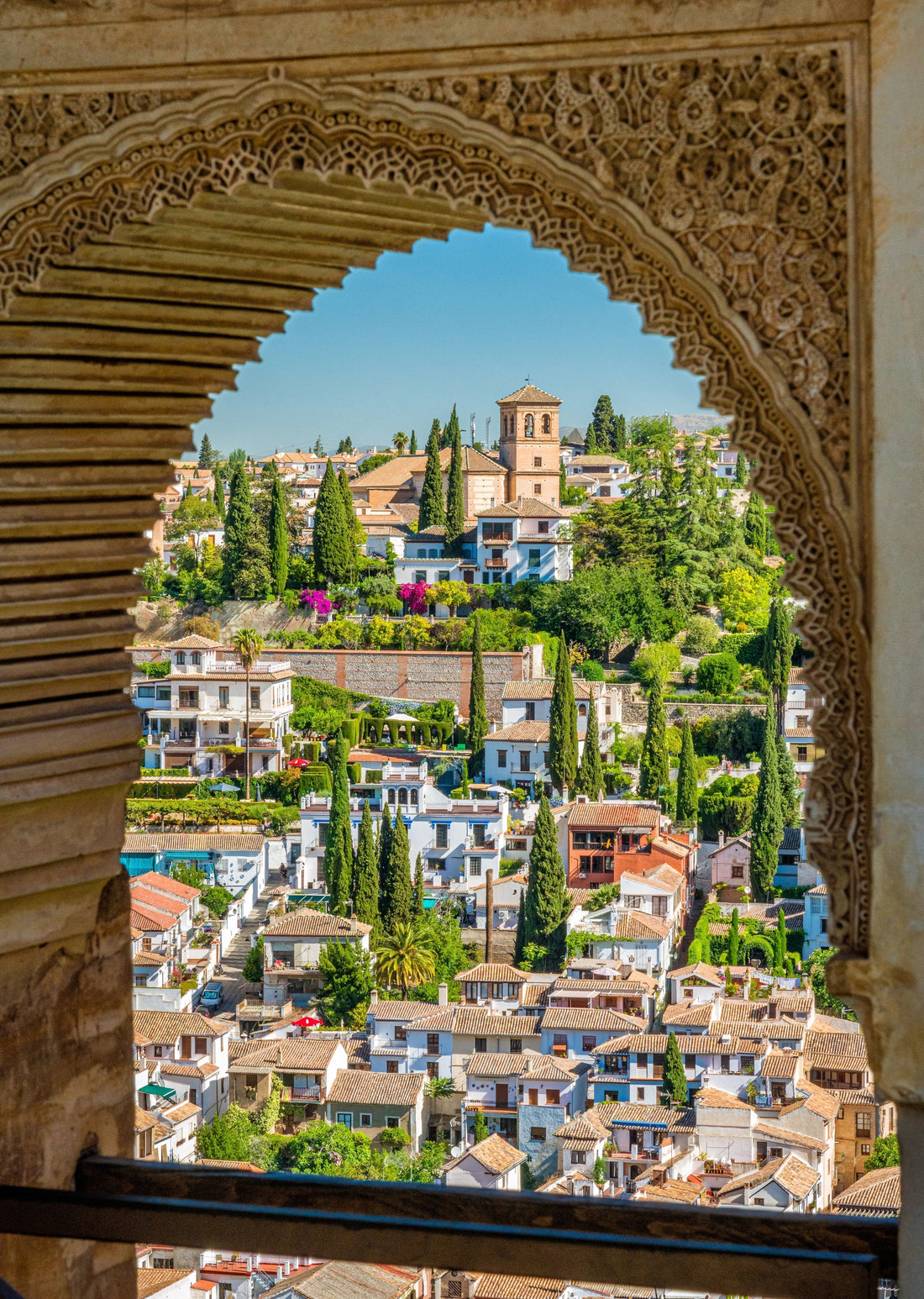
Visiting the Alhambra in Granada, Spain: Complete Travel Guide
Granada, nestled at the foot of Spain’s snow-capped Sierra Nevada mountains, is one of the most magical cities in Andalusia. Its narrow lanes are filled with Moorish charm, flamenco rhythms, and the scent of orange blossoms. At its heart lies the Alhambra, a sprawling palace-fortress complex that embodies centuries of Islamic art, Christian influence, and Spanish heritage. Once the royal court of Ferdinand and Isabella, and the place where Columbus secured approval for his voyage to the New World, the Alhambra stands as a living testament to Europe’s layered history.
If you’re planning a trip through southern Spain, visiting the Alhambra is simply a must. Here’s everything you need to know before you go.

Granada, sunlit streets buzzing with life as people relax at open-air cafés beneath the warm Andalusian sky /Depositphotos

Granada, a panoramic city view of whitewashed houses nestled among lush green trees beneath the clear Andalusian sky /Depositphotos
A Brief History of the Alhambra
The story of the Alhambra begins in 889 AD, when it was built as a small fortress atop ancient Roman ruins. During the 13th to 15th centuries, the Nasrid dynasty, the last Muslim rulers of Spain, expanded it into a royal residence of exquisite palaces, intricate courtyards, and ornamental gardens. When the Christian Reconquista reached Granada, Emperor Charles V added a Renaissance palace within its walls, merging two artistic worlds.
Today, this UNESCO World Heritage Site is a breathtaking blend of Moorish, medieval, and Renaissance styles. Its name derives from the Arabic al-Ḥamrā, meaning “The Red One,” inspired by the deep reddish hue of its sun-baked walls glowing against the Andalusian sky.

Granada, the Albaicín district unfolding in a maze of whitewashed houses and cobblestone streets overlooking the majestic Alhambra /Depositphotos

Granada, the Alhambra rising majestically from the hillside, surrounded by cypress trees and framed by the distant Sierra Nevada mountains /Depositphotos
What to See at the Alhambra
1. Alcazaba
The oldest section of the Alhambra, the Alcazaba is a military fortress that once guarded the city. Climb its ancient watchtowers, especially the Torre de la Vela, for panoramic views of Granada’s rooftops and the distant Sierra Nevada peaks.

Granada, a serene Alhambra courtyard with a reflective pond, green trees, and a charming brick pavilion bathed in soft sunlight /Depositphotos
2. Nasrid Palaces
The true heart of the Alhambra, these palaces are masterpieces of Islamic art. Every archway and tile tells a story through delicate carvings, geometric mosaics, and the mesmerizing honeycomb ceilings of the Hall of the Ambassadors. Entry is strictly timed, so plan ahead and arrive promptly.
Tip: Arrive right on time for your slot, late entry is not permitted.

Granada, the Nasrid Palaces’ iconic Court of the Lions, where elegant marble columns surround the famous lion fountain beneath intricate Moorish arches /Depositphotos
3. Palace of Charles V
Built in the 1500s, this Renaissance palace represents the Christian reassertion of power. Its dramatic circular courtyard framed by two tiers of columns feels like stepping into an open-air amphitheater, a bold contrast to the surrounding Moorish elegance.

Granada, the Palace of Charles V courtyard showcasing its grand circular colonnade and harmonious Renaissance symmetry under the bright Andalusian sky /Depositphotos
4. Generalife Gardens
Once the summer retreat of Granada’s sultans, the Generalife is a tranquil escape of terraced gardens, flower-lined walkways, and gently splashing fountains. The rhythmic sound of water and the scent of jasmine make it an oasis of peace high above the city.


Granada, the Generalife Gardens seen from different angles, where flowing fountains, terraced flowers, and cypress-lined walkways create a tranquil retreat /Depositphotos
Granada, the Generalife Gardens illuminated at night, with softly glowing arches, shimmering pools, and moonlit reflections among the trees /Depositphotos
5. Mirador de San Nicolás
For the postcard-perfect view, head to this viewpoint in the Albaicín neighborhood at sunset. As the last light hits the fortress walls and the mountains blush pink, the Alhambra looks almost otherworldly, a sight you’ll never forget.

Granada, the Albaicín neighborhood during the day, with winding cobblestone streets, whitewashed houses, and views of the Alhambra glowing under the Andalusian sun /Depositphotos

Granada, the Albaicín neighborhood at night, where lantern-lit alleys and lively terraces reveal the city’s timeless Moorish charm beneath a starlit sky /Depositphotos
Essential Tips for Visiting the Alhambra
Buy tickets early. Nasrid Palace slots often sell out weeks ahead, especially in summer. Use the official ticket site to secure your preferred time.
Allow at least 3–4 hours. There’s so much to see that you’ll want to explore at a relaxed pace.
Bring water and light snacks. There are limited food options inside.
Wear comfortable shoes. Many paths are cobblestoned or uneven, and you’ll walk a lot.

Granada, El Patio at the Alhambra, where elegant arches frame a tranquil reflecting pool surrounded by intricate Moorish carvings and blooming courtyards /Depositphotos
Other Things to Do in Granada
After exploring the Alhambra, discover Granada’s other gems. Step inside the Granada Cathedral, a Renaissance marvel of soaring white and gold interiors. Visit the Royal Chapel, where Ferdinand and Isabella rest beside their legacy of a unified Spain.

Granada, the majestic exterior of Granada Cathedral, its grand Renaissance façade rising proudly over the historic city center /Depositphotos


Granada, the interior of Granada Cathedral, filled with soaring white columns, golden details, and soft light filtering through high stained-glass windows /Depositphotos

Granada, the Royal Chapel of Granada, where the ornate marble tombs of Ferdinand and Isabella rest beneath intricate Gothic vaults /Depositphotos
Stroll through the Albaicín Quarter, a maze of Moorish alleys filled with tea houses, small squares, and artisan shops. By evening, join locals on Calle Navas, Granada’s famous tapas street, where each drink comes with a complimentary dish. Don’t miss the Alcaicería Market, once the city’s bustling silk bazaar, now a colorful labyrinth of stalls selling ceramics, spices, and handmade crafts.
Granada, the Albaicín neighborhood from above, revealing a sea of whitewashed houses, terracotta rooftops, and winding alleys cascading down the hillside toward the Alhambra /Depositphotos
Final Thoughts
The Alhambra is far more than an architectural wonder, it’s a symbol of coexistence between cultures and eras. Wandering through its palaces and gardens, you’ll sense the whispers of poets, rulers, and dreamers who once walked the same halls. Spend at least half a day soaking in its history, linger for sunset at Mirador de San Nicolás, and let Granada’s blend of art, music, and passion complete your Andalusian journey.


